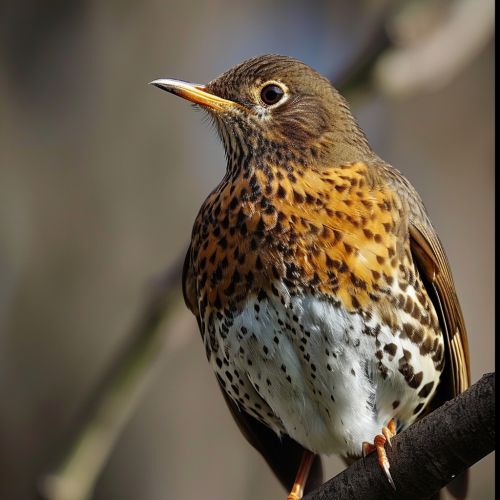Thrush (bird)
Classification and Species
The thrush is a member of the Turdidae family, a group of passerine birds that occur worldwide. This family consists of over 300 species, many of which are known as thrushes. The term "thrush" is used to denote birds in this family that have a certain characteristic song and appearance. The most common species of thrush include the American robin, the song thrush, and the mistle thrush.


Description
Thrushes are small to medium-sized birds, typically measuring between 20 and 30 cm in length. They are characterized by their rounded bodies, long legs, and strong feet. The plumage of thrushes is usually brown or grey on the upper parts, with a speckled or spotted chest. The beak is medium-sized and straight, suitable for their diet of insects and fruit.
Distribution and Habitat
Thrushes are found all over the world, with the highest diversity in the Old World. They inhabit a wide range of habitats, from forests and woodlands to gardens and parks. Some species, like the American robin, have adapted well to human environments and are common in urban and suburban areas.
Diet and Feeding
Thrushes are omnivorous birds, feeding on a diet that includes insects, earthworms, berries, and fruits. They forage on the ground, using their strong beaks to probe the soil for invertebrates. During the breeding season, they primarily feed on insects and other small invertebrates to provide protein for their growing chicks.
Breeding and Nesting
Thrushes are known for their elaborate and well-constructed nests, usually built in trees or shrubs. The female is primarily responsible for nest construction, using materials such as grass, twigs, and mud. The nests are often lined with soft materials for the eggs and chicks.
Thrushes typically lay between 3 and 5 eggs per clutch, with the female incubating the eggs for about two weeks. After hatching, the chicks are fed by both parents until they are ready to fledge, usually after two weeks.
Song and Call
One of the most distinguishing features of thrushes is their song. These birds are known for their melodious and complex songs, often heard during the early morning and late evening. The song is typically a series of varied phrases and notes, repeated several times. In addition to their song, thrushes also have a variety of calls used for communication, including alarm calls and contact calls.
Conservation Status
The conservation status of thrushes varies by species. Some species, like the American robin, are common and widespread, while others are threatened or endangered due to habitat loss, pollution, and climate change. Conservation efforts for these species often involve habitat protection and restoration, as well as public education about the importance of these birds.
